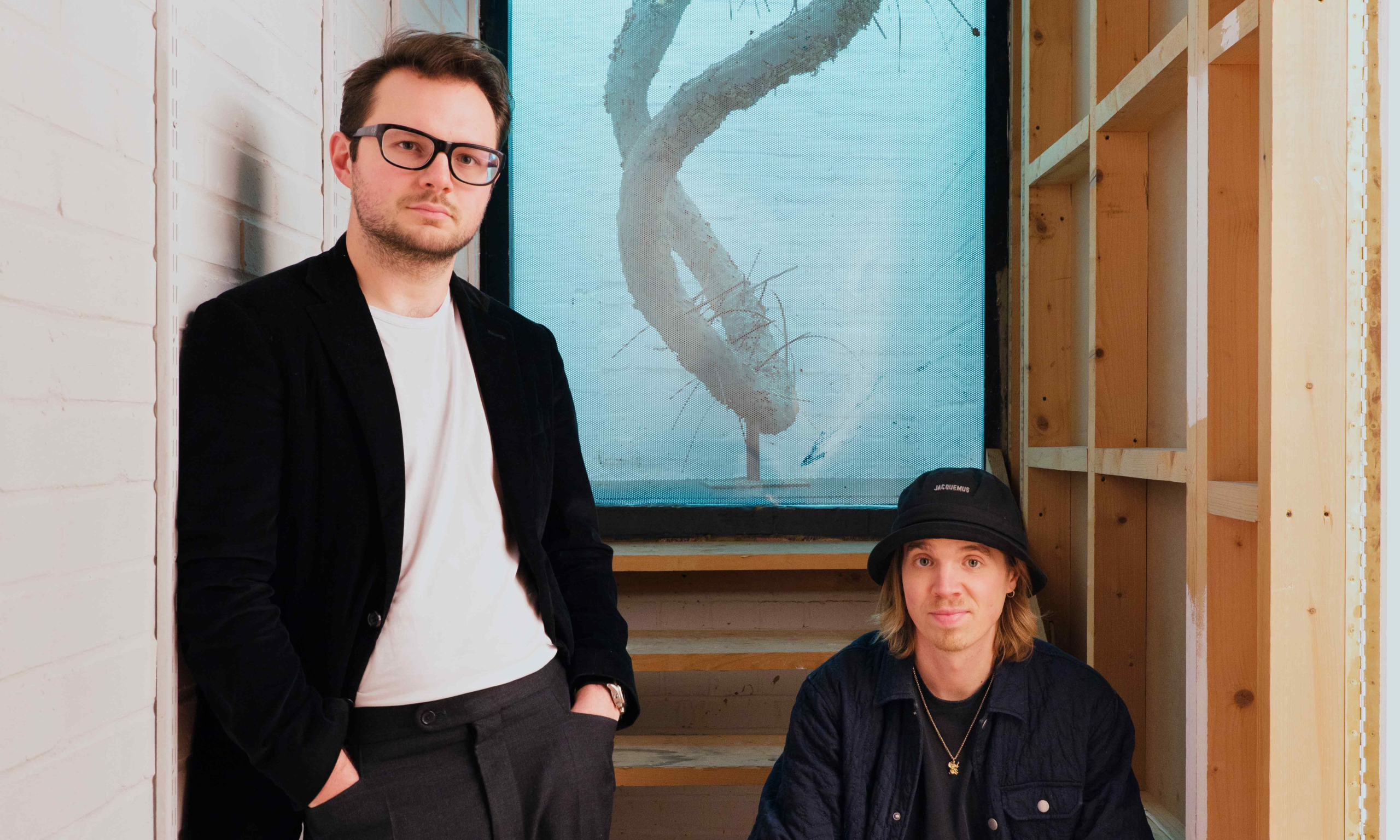Will Hainsworth, left, and Lucas Giles in front of Gusty Ferro's Untitled (8) (2023)
Photo: Harry Mitchell
Versatility is a chief concern of many London gallerists right now, as they grapple with the realities of the current economic climate. This is especially true of a brand new gallery, which will open in the prestigious Lisson Grove with a programme focused on cross-disciplinary art and collaboration.
Palmer Gallery, launching in March, is the creation of the academic and writer Lucas Giles and the art advisor Will Hainsworth. Their mission is to bring together work by artists practising across a range of disciplines—from painting, video, sculpture, sound and more. They will collaborate with artists working primarily with one discipline, too. But in this case, they will invite them to suggest someone with whom they can exhibit, to create dialogues and ensure that each show contains at least three or four mediums.
Hainsworth explains that the project is in part a reaction against a market that has become too focused on painting. “We both feel that the London art scene at the moment is very vibrant, but it's quite focused on young painters and seems to be very transient,” he says. “If you speak to artists, a lot of them, even though their practice might be founded in something more mainstream, like painting or sculpture, want to experiment out in different directions.”
Giles adds that ideas of flexibility and freedom, so commonly associated with a cross-disciplinary practice, are key to the kind of relationships they want to build with their artists. “We like this idea of giving our space over to an artist, and felt that a cross-disciplinary focus will give them more license to be able to transform it into something that aligns with their vision,” he says.
The cupboard spaces are one of several unusual features in the gallery space
Photo: Harry Mitchell
The pair certainly have a site suitable for bold thinking. The gallery is housed in a former factory once owned by the Palmer Tire Company, which during the Second World War produced parts for fighter aircrafts, such as the Spitfire and the Lancaster Bomber. Later used as an office by Giles’s parents, it is a remarkably varied and unusual space: there are tall ceilings, cupboard-like recesses built into the walls, and a small, hidden side gallery for “immersive” installations.
Many of the nooks and crannies will be utilised for the first show, a group exhibition titled Field of Difference (opening 8 March). Setting the tone for Palmer’s programme, it will feature virtually all new works, including a sculptural painting by Albano Hernández, featuring machine cut slices of coloured ceramic; a CGI film by Divine Southgate-Smith, representing what the gallery describes as “a surreal, digital desert”; and a wall-based sculpture by Bea Bonafini, in which strips of carpet are accented with pastels. The side gallery, meanwhile, will display a twisting sculpture by Gusty Ferro made out of straw, cable-ties, coins and concrete, accompanied by a sound installation and strobe lighting.
Works in Palmer Gallery's inaugural show include Bea Bonafini's Alien Vibrations (2023) and Albano Hernandez's P23.65 (2023)
Courtesy of Palmer Gallery
Future programming already in place promises further variety, with the second exhibition likely to draw particular attention—it will show work by Boris Eldagsen, the photographer who won a Sony Photography Award last year, only to reject it after revealing the image had been created using AI. There will also be solo shows for artists such as Max Boyla, a recent graduate from the Royal Academy Schools whose practice spans disciplines including painting, ceramics and light installation. Down the line, there are plans for events crossing into the worlds of fashion, music and food.
The decision to open Palmer Gallery comes at an interesting, and challenging, time for London’s dealers, many of whom are taking a “go or grow” approach in the face of financial pressures, expanding into new locations and larger spaces. There is a clear sense that the team behind Palmer will do things their own way, and at their own pace: they will not be representing artists, for example, until they have the foundations to support them more fully. They also express hope that their disparate professional backgrounds—Hainsworth having worked at Victoria Miro and Unit London among others, and Giles having spent recent years earning a PhD focused on digitally reconstructing lost pieces of medieval Italian architecture—can bring something fresh to the table.
Paintings by Jennifer Carvalho, including Judith & Abra (Artemesia) (2023) will also be included in the gallery's first show. These works often draw on early Renaissance imagery
Courtesy of Palmer Gallery
They acknowledge, however, that they remain very much part of an ecosystem, and there is an undeniable symbolism in their opening nearby to Lisson Gallery. Their blue-chip neighbour was one of the earliest champions of conceptual art (the gallery’s current roster includes Ai Weiwei, Marina Abramović and Anish Kapoor.) Hainsworth sees Palmer Gallery as a potential “spiritual successor” of Lisson in their mission to foster the careers of young, daring artists, and the two galleries are already in discussion about alignment on future events and openings.
The ultimate aim, it appears, is to be open in every possible way. “I would like people to come away thinking this is an exciting, welcoming, warm, communicative, collaborative environment,” Giles says. “Those are the key pillars we're trying to create.”

